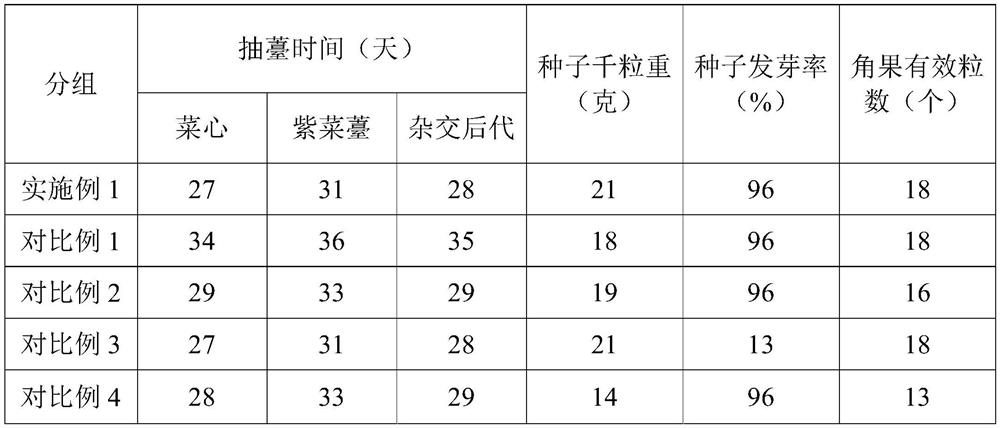Breeding method for rapidly transforming purple flowering Chinese cabbage gene to flowering Chinese cabbage
A technology of seaweed stalks and cabbage stalks, which is applied in the field of breeding, can solve the problems of the flowering period of the cabbage stalks and laver stalks and the long breeding time, and achieve the effects of saving labor and land costs, wide application range, and improving breeding efficiency
- Summary
- Abstract
- Description
- Claims
- Application Information
AI Technical Summary
Problems solved by technology
Method used
Image
Examples
Embodiment 1
[0029] A breeding method for quickly transferring the laver stalk gene to Chinese cabbage, comprising the following steps:
[0030] (1) After the cabbage heart and seaweed sprouts were sown separately, the cabbage heart was cultured under the condition of constant temperature of 25°C in alternating light and dark, the cycle of light and dark alternating was 16h / 8h, and the light intensity was 250umol / m 2 s, the light spectrum is white: red = 3:1; laver sprouts are cultured under alternating light and dark conditions under variable temperature conditions, the light and dark cycle and temperature are 16h, 25°C / 8h, 10°C, and the light intensity is 250umol / m 2 s; water-soluble compound fertilizers were applied when Chinese cabbage and laver sprouts were cultivated to 20 days;
[0031] (2) When cabbage stalks and laver stalks are bolting and blooming, artificial hybridization is carried out with laver stalks as the female parent and cabbage stalks as the male parent, and the top gr...
Embodiment 2
[0036] A breeding method for quickly transferring the laver stalk gene to Chinese cabbage, comprising the following steps:
[0037] (1) After the cabbage heart and seaweed sprouts were sown separately, the cabbage heart was cultured under the condition of constant temperature of 25°C in alternating light and dark, the cycle of light and dark alternating was 16h / 8h, and the light intensity was 250umol / m 2 s, the light spectrum is white: red = 3:1; laver sprouts are cultivated under temperature-controlled conditions by alternating light and dark, the cycle of light and dark alternates and the temperature is 16h, 25°C / 8h, 10°C, and the light intensity is 250umol / m 2 s; water-soluble compound fertilizers were applied when Chinese cabbage and laver sprouts were cultivated to 25 days;
[0038] (2) When cabbage stalks and laver stalks are bolting and blooming, artificial hybridization is carried out with laver stalks as the female parent and cabbage stalks as the male parent, and the...
Embodiment 3
[0043] A breeding method for quickly transferring the laver stalk gene to Chinese cabbage, comprising the following steps:
[0044] (1) After the cabbage heart and seaweed sprouts were sown separately, the cabbage heart was cultured under the condition of constant temperature of 25°C in alternating light and dark, the cycle of light and dark alternating was 16h / 8h, and the light intensity was 250umol / m 2s, the light spectrum is white: red = 3:1; laver sprouts are cultivated under temperature-controlled conditions by alternating light and dark, the cycle of light and dark alternates and the temperature is 16h, 25°C / 8h, 10°C, and the light intensity is 250umol / m 2 s; water-soluble compound fertilizers were applied respectively when Chinese cabbage and laver sprouts were cultivated for 30 days;
[0045] (2) When cabbage stalks and laver stalks are bolting and blooming, artificial hybridization is carried out with laver stalks as the female parent and cabbage stalks as the male pa...
PUM
 Login to View More
Login to View More Abstract
Description
Claims
Application Information
 Login to View More
Login to View More - R&D
- Intellectual Property
- Life Sciences
- Materials
- Tech Scout
- Unparalleled Data Quality
- Higher Quality Content
- 60% Fewer Hallucinations
Browse by: Latest US Patents, China's latest patents, Technical Efficacy Thesaurus, Application Domain, Technology Topic, Popular Technical Reports.
© 2025 PatSnap. All rights reserved.Legal|Privacy policy|Modern Slavery Act Transparency Statement|Sitemap|About US| Contact US: help@patsnap.com

